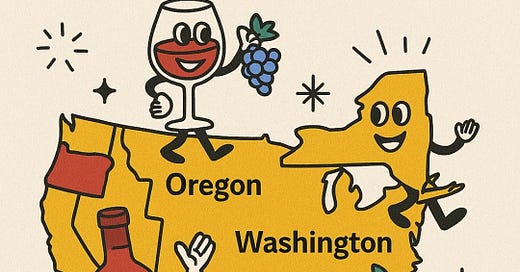The American Wine Tapestry Begins
From colonization to Cabernet: a prelude to America in the glass
You could argue that American wine began with failure.
For centuries, European settlers tried to tame the land with vines from home — only to watch them wither under foreign climates, native diseases, and tenacious American pests. The wild vines that did grow here, like Vitis labrusca, yielded wines most deemed undrinkable. So wine, for a long time, became a story of trying to make Europe work in America.
And yet, what grew from those early struggles became one of the most dynamic, diverse, and consumer-driven wine cultures in the world.
This is the beginning of that story — and a prologue to our journey through the four pillars of American wine: California, Oregon, Washington, and New York.
A Patchwork, Not a Pyramid
Unlike countries like France or Italy, the United States doesn’t have a centralized wine system rooted in centuries of regional tradition. Instead, it’s a patchwork: 50 states, 11,500+ wineries, and a wildly inconsistent legal landscape.
But four states drive the conversation:
California: 85% of U.S. wine production. The fourth largest producer in the world. A wine country of countries.
Washington: High-value reds from dry, sunny slopes. A Cabernet powerhouse in the Pacific Northwest.
Oregon: Pinot Noir with pedigree, from winemakers who wanted more Burgundy than blockbuster.
New York: Cold-climate resilience meets rising Riesling reputations, especially in the Finger Lakes and Long Island.
Each one has its own climate, culture, and challenges. And none of them tell the full story alone.
First Comes Colonization
Wine arrived on American soil with colonization. Spanish missionaries brought grapes to California in the 1700s, planting Mission vines for sacramental wine. British and Dutch settlers on the East Coast tried to plant European varieties — unsuccessfully.
The problem? Europe’s Vitis vinifera vines didn’t stand a chance against North America’s native pests and fungal diseases. The solution, for a while, came from hybrids — like the Alexander grape (a cross of vinifera and native labrusca), discovered in Pennsylvania.
From the 1800s through Prohibition, the U.S. wine industry expanded in fits and starts, often regionally. Wine was made in Ohio, Missouri, Virginia, and New York. But everything changed in 1920.
Prohibition: The Great Pause
When national Prohibition hit, it destroyed America’s nascent wine culture.
Legal wine was restricted to religious or medicinal use. Wineries closed. Skilled winemakers disappeared. Many vineyards were replaced with table grapes. The wine that survived was often homemade — with mixed results.
When Prohibition ended in 1933, wine wasn’t the drink of choice. Spirits and beer were faster, cheaper, and easier to distribute. Wine became niche, sometimes suspicious, and often cheap.
The rebuilding took decades.
The Rise of the AVA: Identity in a Young Landscape
As America’s wine culture matured, so did its geography. In 1980, the U.S. established its first American Viticultural Area (AVA): Augusta, Missouri. Napa Valley followed soon after.
Today there are over 260 AVAs. They function like appellations in Europe but with fewer restrictions. AVAs define origin — not grape variety, not style. A wine labeled with a specific AVA must have 85% of its grapes grown there. But otherwise, winemakers have wide freedom.
This freedom is both the strength and the confusion of American wine. It allows creativity and experimentation — but it also makes consistency hard to define, especially for export markets.
Oregon is stricter (95% AVA grapes, 90% varietal content). California is more relaxed. Rules vary by state. So while AVAs give wines a sense of place, they don’t guarantee a sense of style.
The Wine Club Economy
Unlike many Old World regions, direct-to-consumer sales drive much of the American wine business. Especially for small and mid-size wineries, wine clubs and cellar door visits are core to survival.
This is partly because of the U.S.’s three-tier distribution system, a post-Prohibition relic that complicates interstate alcohol sales. In short: a winery in Oregon might find it easier to ship to London than to Louisiana.
That’s why many wineries invest in beautiful tasting rooms, personalized club experiences, and storytelling. Wine in America isn’t just a beverage — it’s an experience economy.
Wine in All 50 States?
Yes. Wine is legally made in all 50 states — from Arizona to Alaska. But four dominate by volume and reputation:
California (85%)
Washington State (5%)
New York (3%)
Oregon (2%)
These states don’t just make the most wine — they shape the conversation. Each represents a different climatic edge, cultural perspective, and winemaking challenge.
That’s why the rest of this series will explore them in depth.
What’s Coming Next
Part 2 will begin with California — the giant of American wine. But we won’t stop at Napa.
We’ll talk:
Coastlines and canyons
Zinfandel’s identity crisis
Cabernet's range from Rutherford to Paso
Why Lodi deserves more love
And how sustainability movements like “Napa Green” and “Lodi Rules” are reshaping what quality means
Then, we’ll head north to Oregon’s Pinot soul, east to Washington’s structured reds, and finish in New York, where cold resilience meets cool elegance.
Closing Sip
American wine doesn’t move in a straight line. It zigzags between ambition and adversity, freedom and fragmentation. It holds both Gallo and Screaming Eagle in the same breath. It built a wine culture from scratch — and it’s still writing its story.
Let’s raise a glass to that.
And get ready for the next chapter.



I enjoyed reading this well written article. Thanks Anna.